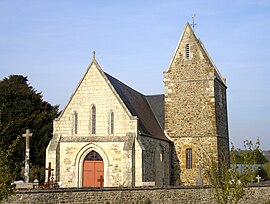Combray
Combray | |
|---|---|
 The church in Combray | |
show Location of Combray | |
 Combray | |
| Coordinates: 48°57′00″N 0°26′17″W / 48.95°N 0.4381°WCoordinates: 48°57′00″N 0°26′17″W / 48.95°N 0.4381°W | |
| Country | France |
| Region | Normandy |
| Department | Calvados |
| Arrondissement | Caen |
| Canton | Thury-Harcourt |
| Intercommunality | Cingal-Suisse Normande |
| Government | |
| • Mayor (2008–2014) | Daniel Margueritte |
| Area 1 | 4.51 km2 (1.74 sq mi) |
| Population (Jan. 2018)[1] | 146 |
| • Density | 32/km2 (84/sq mi) |
| Time zone | UTC+01:00 (CET) |
| • Summer (DST) | UTC+02:00 (CEST) |
| INSEE/Postal code | 14171 /14220 |
| Elevation | 88–230 m (289–755 ft) (avg. 187 m or 614 ft) |
| 1 French Land Register data, which excludes lakes, ponds, glaciers > 1 km2 (0.386 sq mi or 247 acres) and river estuaries. | |
Combray is a commune in the Calvados department in Normandy in north-western France.[2]
Combray is also an imagined village in Marcel Proust’s À la recherche du temps perdu (In Search of Lost Time), a book which was strongly inspired by the village of his childhood, Illiers, which has now been renamed Illiers-Combray in his honor. Combray is the title of the first part of the first volume of À la recherche du temps perdu, titled Du côté de chez Swann (Swann's Way).
There is a medieval motte-and-bailey castle.[3]
Population[]
| Year | Pop. | ±% |
|---|---|---|
| 1962 | 122 | — |
| 1968 | 123 | +0.8% |
| 1975 | 95 | −22.8% |
| 1982 | 100 | +5.3% |
| 1990 | 98 | −2.0% |
| 1999 | 130 | +32.7% |
| 2008 | 130 | +0.0% |
See also[]
- Marcel Proust
- Illiers-Combray
References[]
- ^ "Populations légales 2018". INSEE. 28 December 2020.
- ^ Combray sur le site de la communauté de communes Archived 2010-07-31 at the Wayback Machine
- ^ Arcisse de Caumont, Statistika monumentalne Calvados
| Wikimedia Commons has media related to Combray (Calvados). |
Categories:
- Communes of Calvados (department)


